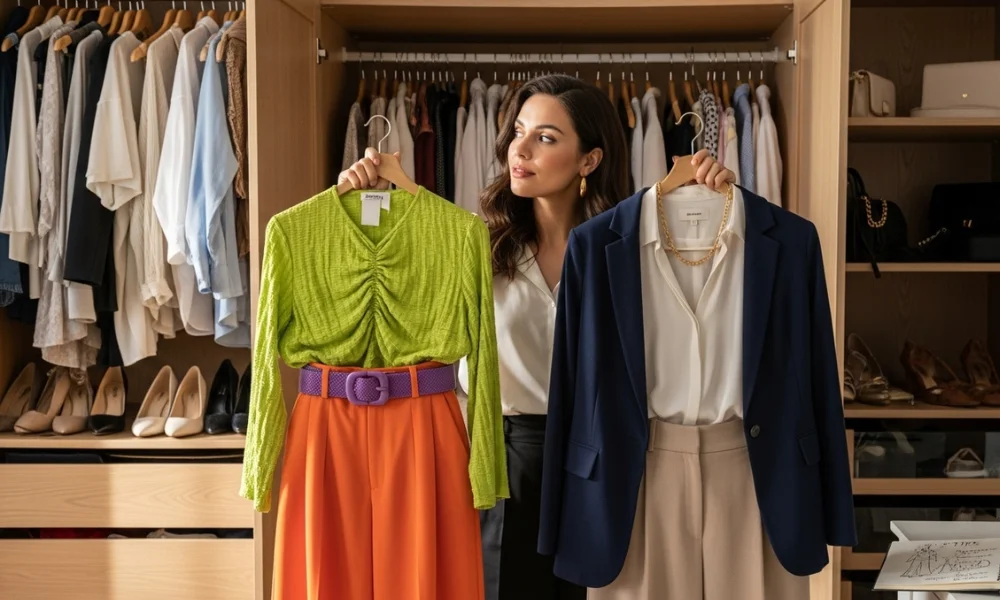Even stylish people sometimes make small errors that ruin a great outfit. These fashion styling mistakes can break proportions, weaken colours, and reduce overall polish. This Pravi Celer guide explains common missteps and teaches quick ways to fix them. With a few adjustments, you’ll look confident, modern, and express your true style.
What Are the Most Common Fashion Styling Mistakes?
A styling mistake isn’t just breaking outdated rules or ignoring fashion advice. It’s wearing items that distort balance, clash with body shape, or ignore context. Avoiding these fashion styling mistakes instantly elevates your wardrobe without major spending or effort. Knowing the traps makes your style more timeless and personally expressive.
Top Styling Mistakes & How to Fix Them

Wearing Ill-Fitting Clothes
Clothes that are too tight or loose instantly cheapen even expensive and trendy outfits. Bad fit distorts your shape and makes lines hang incorrectly on the body. Take proper measurements yearly and choose tailoring for hemlines, waists, and shoulders. A small adjustment transforms ordinary pieces into garments that look custom-made.
Extra Tip: Shoulder seams should align with your bone edge, and trousers should break slightly at the shoe. If between sizes, choose the larger and tailor down for a superior fit and comfort. Keep a trusted tailor contact for fast adjustments and repairs. Fit precision separates amateur dressing from professional-looking style.
Ignoring Your Body Shape
Choosing silhouettes that accentuate your shape highlights strengths and conceals weaknesses. Understanding your proportions helps you select cuts that naturally flatter you. Identify your body type and keep a list of dependable styles. Balanced lines create harmony and confidence, making outfits look more intentional and polished.
Extra Tip: Use visual tricks to balance proportions: vertical stripes elongate, belts define waists, structured shoulders broaden narrow frames. Photograph yourself in different silhouettes to see which ones enhance your posture. Over time, build a “signature cut” wardrobe around these winning shapes. Personal knowledge beats guessing at trends and reduces fashion styling mistakes.
Poor Fabric Choice or Quality
Cheap fabrics wrinkle quickly and make outfits look worn after a few wears. They may cling awkwardly or reveal more than intended under bright lights. Check fabric labels for natural fibres and test drape before purchasing. Investing in fewer high-quality pieces creates a wardrobe that looks elegant longer.
Extra Tip: Learn to feel fabric weight and weave; heavier cloths drape better and resist wrinkles. Consider seasonal appropriateness: linen works in summer, wool blends in winter. Pay attention to lining quality, as it influences comfort and structure. Good fabrics hold colour and shape, saving money over time.
Over-Accessorising or Mismatched Accessories
Too many accessories can overwhelm an outfit and confuse visual balance. Clashing metals or colours make a polished look appear messy and unplanned. Choose one statement item, then keep the remaining accessories minimal and cohesive. Coordinating textures and tones creates a refined and intentional style impression.
Extra Tip: Apply the “rule of three”: no more than three visible accessories at once. Balance bold earrings with subtle necklaces or choose either statement shoes or a statement bag. Neutral-toned belts and bags act as grounding pieces. Editing accessories is a skill that creates instant sophistication.
Wearing the Wrong Shoes
Shoes that clash with outfits ruin proportions and disrupt overall style flow. Too casual or overly formal footwear sends mixed messages about your look. Plan outfits from the shoes upward and match color depth carefully. Balanced footwear complements clothing and effectively grounds the entire silhouette.
Extra Tip: Keep a small shoe capsule: classic pumps, sleek sneakers, neutral boots, versatile flats. Clean and maintain shoes regularly; scuffed footwear drags down even designer clothes. Coordinate shoe textures with the outfit fabrics for a cohesive look. Good footwear posture also improves how clothes hang on your body and prevents obvious fashion styling mistakes.
Not Dressing for the Occasion
Ignoring context leads to being overdressed, underdressed, or looking out of place. Each event or setting carries its own style expectations and unspoken codes. Check invitations or research venues to plan outfits that are both appropriate and comfortable. Dressing intentionally shows respect for others and instantly boosts your self-confidence.
Extra Tip: Build “occasion outfits” in advance: a polished business look, a semi-formal dinner ensemble, a casual weekend uniform. This prevents panic dressing and mistakes before events. Add flexible layers like blazers or scarves to adjust formality on the go. Preparation keeps you poised under pressure.
Over-Following Trends Instead of Building Personal Style
Chasing every trend creates closets full of items that don’t suit you. Personal style gets lost when you copy instead of curating thoughtfully. Select only trends aligning with your existing wardrobe and body shape. This approach keeps your look modern without losing authenticity or wasting money.
Extra Tip: Make mood boards of outfits that feel authentic, not just trendy. Before buying, ask if a piece complements at least three things you own. Invest in timeless staples, white shirts, tailored trousers, classic coats and add seasonal accents. Over time, trends should highlight, not dominate, your identity.
Wrong Colour Combinations or Ignoring Skin Tone
Poor colour pairing can wash out complexions and disrupt outfit harmony completely. Identify your undertones to choose colours that enhance natural brightness and contrast. Build a palette of flattering shades to simplify shopping and styling decisions. Consistent colours create a signature look and make mixing pieces easier.
Extra Tip: Warm undertones suit earthy and golden hues; cool undertones prefer jewel and icy shades. Test fabrics near your face in natural light for accurate colour reading. Use complementary contrasts, such as dark against light or textured against smooth, for dynamic yet balanced outfits. Smart colour pairing elevates even simple clothes.
Neglecting Garment Care and Maintenance
Wrinkled, stained, or pilled clothes undermine even the most stylish outfits. Proper washing, storage, and rotation extend garment life and preserve appearance. Learn basic care instructions and invest in tools like steamers or lint removers to enhance your cleaning experience. A cared-for wardrobe signals professionalism, attention, and respect for personal style.
Extra Tip: Rotate delicate items so they rest between wears, reducing fibre stress. Use padded hangers to maintain shoulder shape and breathable garment bags for storage. Quick fixes, such as portable stain pens, prevent disasters on busy days. Consistent maintenance makes every outfit look freshly chosen.
Ignoring Proportions and Silhouette
Unbalanced layers or awkward lengths create bulk and distort your natural shape. Balance volume by pairing fitted items with looser pieces for harmony. Tailor hemlines and sleeve lengths to enhance vertical lines and proportion. Clean silhouettes project confidence and make outfits appear well-designed and deliberate.
Extra Tip: Apply the “two-thirds rule”: top and bottom pieces should create pleasing visual ratios. Crop jackets over long dresses or tuck tops into high-waist bottoms to lengthen legs. Photographs help you evaluate proportion mistakes objectively. Mastering silhouette turns simple clothing into artful styling.
Overbranding and Logo Overload
Heavy logos or multiple brand names make outfits look cluttered and less elegant. Quiet luxury favours subtle branding and refined details over bold labels. Choose one branded item and balance it with neutral supporting pieces. This approach feels current and signals confidence rather than status chasing.
Extra Tip: Focus on craftsmanship, fabric, and fit instead of visible brand marks. Mix high and low pieces seamlessly for a modern and individual aesthetic. Let accessories or cuts speak louder than logos. Minimal branding ensures longevity and adaptability across different social settings.
Fast Fashion Pitfalls and Sustainability Mistakes
Buying excessively cheap trends can create clutter and contribute to wasteful practices. Low-cost items often lack durability, leading to repeated purchases and styling frustration. Shift to quality basics and supplement with occasional sustainable or vintage finds. This saves money, elevates style, and reduces environmental impact simultaneously.
Extra Tip: Create a “purchase pause” rule: wait 24 hours before buying new pieces. Research brands’ sustainability ratings and fabrics’ longevity. Rework existing garments with tailoring or accessories instead of discarding. Conscious shopping transforms your wardrobe and your style reputation.
Personalise Your Style with Tailoring and Wardrobe Building
Tailoring small adjustments transforms inexpensive garments into flattering and polished pieces. Build a capsule wardrobe of versatile basics, reducing impulse mistakes and clutter. Mix trendy accents sparingly to refresh staples without losing cohesion. This method saves money while ensuring every outfit expresses your identity.
Extra Tip: Keep a seasonal checklist for wardrobe gaps; fill them deliberately, not impulsively. Tailor secondhand finds to create unique and eco-friendly pieces. Photograph complete outfits to speed daily dressing. Personalised planning turns dressing from a source of stress into a form of self-expression.
Regional and Climate-Aware Styling Tips
Ignoring local climate or culture leads to discomfort and style missteps. Select fabrics and cuts suited to your weather and lifestyle conditions. Adapt global trends with regional fabrics or tailoring for authenticity and comfort. This thoughtful approach yields a style that feels natural and effortless in daily life.
Extra Tip: Use breathable cottons and linens in hot climates, layered wools in cooler seasons. Consider modesty or movement needs when adapting global cuts. Draw inspiration from local artisans or traditional patterns for a unique signature. Context-aware dressing enhances practicality and originality simultaneously.
Colour Psychology and Mood in Styling
Colours don’t just flatter your skin; they influence emotions and impressions deeply. Wearing energising shades like red or orange projects confidence and draws attention naturally. Soft blues and greens evoke a sense of calm, trust, and approachability in social or work settings. Understanding colour psychology allows you to choose outfits that match your desired mood or message.
Extra Tip: Experiment with accent colours in accessories or layers before committing fully. Keep a palette card of your best colours for quick shopping reference. Combine one mood-setting colour with neutrals to avoid overwhelming an outfit. Strategic colour choices boost both style impact and personal confidence.
Layering and Seasonal Transition Mistakes
Layering incorrectly can add bulk, hide shape, and overheat or under-protect you. Many people ignore proportion or fabric weight when combining multiple pieces. Start with lightweight, fitted bases and add structured outer layers for balance. Remove or add items strategically to seamlessly adapt between indoor and outdoor settings.
Extra Tip: Use contrast in length and texture for dynamic but flattering layers. Belt or define the waist to prevent shapeless stacks of fabric. Choose colour families that harmonise across all layers for cohesion. Mastering layering allows you to extend your wardrobe across seasons without looking sloppy.
Accessory Investment vs. Trends
Accessories can transform outfits, but also drain budgets when bought impulsively. Many people collect trendy pieces that date quickly or don’t match existing wardrobes. Focus on timeless accessories, classic leather belts, neutral handbags, and quality watches that complement multiple looks. This approach saves money while elevating style consistency across seasons.
Extra Tip: Before buying a new accessory, imagine at least three outfits it enhances. Choose durable materials and understated finishes for maximum longevity. Rotate seasonal accents like scarves or statement earrings to refresh staples. Strategic accessory planning keeps your style fresh without endless spending.
Building a Long-Term Style Plan
Developing a personal style plan prevents random purchases and repeated mistakes. Start by defining lifestyle needs, colour palette, and preferred silhouettes in writing. Set seasonal budgets and track gaps rather than shopping on impulse. Over time, this plan creates a wardrobe that feels coherent, functional, and authentic.
Extra Tip: Review your wardrobe twice a year and donate or tailor any unworn pieces. Photograph outfits you love to build a digital “lookbook” for inspiration. Align new purchases with both your plan and upcoming life events. Long-term thinking transforms fashion from a source of stress into a means of self-expression.
Personalise Your Style: Tailoring & Wardrobe Building

How to Find What Works for You (Body + Lifestyle)
Understanding your daily activities and body shape prevents wasting money on unsuitable clothes. Evaluate where you spend most time, office, events, or casual settings and plan accordingly. Take honest photos of outfits to see what truly flatters your shape. Combining self-knowledge with lifestyle needs creates a wardrobe that feels authentic.
Building a Capsule Wardrobe to Avoid Mistakes
A capsule wardrobe is a small set of versatile pieces that mix easily. It saves time each morning, reduces impulse buys, and eliminates styling confusion. Choose neutral foundations, then add a few accent colours for personality. This framework eliminates clutter and maintains a consistent style across seasons.
Investing in Staples vs Trendy Pieces
Staples like tailored blazers, crisp shirts, and neutral-coloured shoes can last for years. Trendy items refresh looks but lose impact quickly, making closets chaotic. Spend more on timeless foundations and only experiment with trends sparingly. This approach strikes a balance between freshness and stability, protecting both your budget and your style identity.
Budget Tips
Set a seasonal spending plan before shopping to avoid emotional purchases. Prioritise items that fill real gaps in your wardrobe rather than duplicates. Use sales for high-quality staples instead of cheap, trendy pieces. Conscious budgeting gives you control and ensures each purchase has purpose.
Regional & Climate-Aware Styling Mistakes

Fabric for Heat/Humidity
Lightweight, breathable fabrics like cotton, lawn, and linen keep you comfortable in the heat. Synthetic heavy blends trap moisture, causing discomfort and creasing easily. Prioritise moisture-wicking or natural fibres for a polished look in hot climates. Good fabric selection maintains both style and health in extreme weather.
Modesty and Cultural Appropriateness
Ignoring local customs can lead to discomfort and social awkwardness at events. Adapt global trends with modest cuts, longer lengths, or layering for respect. Combine traditional silhouettes with modern colours or accessories for a fresh signature style. This creates outfits that feel current yet culturally sensitive.
Available Tailoring and Local Resources
Foreign advice often overlooks the widespread availability of skilled tailoring in South Asia. Use local tailors to customise fits, adjust lengths, and add thoughtful details. Tailoring transforms inexpensive garments into polished, individual pieces that rival designer looks. Leveraging nearby resources turns global trends into uniquely regional expressions.
Mistakes Foreign Advice Doesn’t Cover Well
Many guides ignore heat, modesty, or limited ready-to-wear options in certain regions. Copying Western layering or fabrics often results in impractical and uncomfortable outfits. Replace heavy knits with breathable blends and swap boots for polished sandals. Localising global style tips ensures fashion works for your actual lifestyle.
Checklist: Quick Fixes for Fashion Styling Mistakes
| Mistake | Quick Fix |
|---|---|
| Ill-Fitting Clothes | Get measurements and tailor key pieces. |
| Over-Accessorizing | Choose one statement accessory only. |
| Wrong Shoes | Plan the outfit, starting with footwear. |
| Ignoring Body Shape | Learn about shapes and keep a list of flattering cuts. |
| Poor Fabric Choice | Check labels, invest in better materials. |
| Logo Overload | Choose subtle branding with neutral items. |
| Fast Fashion Trap | Pause purchases, prioritise quality basics. |
Use this checklist before dressing to instantly elevate your daily style and avoid repeated fashion styling mistakes.
Conclusion
Avoiding these fashion styling mistakes saves time, money, and wardrobe frustration. Focus on fit, proportion, colour, and occasion to create cohesive outfits. Incorporate sustainability, personalisation, and climate awareness for a modern and authentic style. With thoughtful choices and Pravi Celer guide, your wardrobe becomes a confident expression of who you are.

